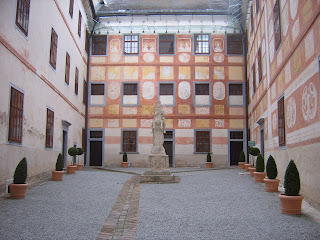Today we left the Alps and headed to Castle Forchtenstien. It lies on the Burganland which is the region that forms the borderland between Austria and Hungary. The main tower was constructed in the 13
th century. The Esterhazy family came to the castle and transformed into a Baroque palace complete with an Italian frescos in the chapel of the holy virgin decorating the ceiling. The murals on the entrance way had images that depicted images from ancient antiquity that had 120 pictures of all the Caesars that comprised the Holy Roman Empire. A fascinating claim made by the Esterhazy family was that they could trace the bloodline all the way back to Dracula, Attila the Hun, and even Adam and eve. This clearly illustrated how the Esterhazy family claimed to have an historical bloodline that would emphasize their power and their supreme nobility within the Burgenland of Austria- Hungary. Paul Esterhazy wrote about the harmony of the heavens, commenting on the overall beauty of the intricate fresco paintings. It was interesting to see how Castle Forckinstien was never besieged by the Turks considering how many times the Turks attacked Austria, trying to expand their empire. Castle Forckinstien also served as an armory and their were countless examples of Austrian weaponry on display ranging from battle armor used in the 30 years war, to the more modern muskets of the 17
th and 18
th century. The display that really caught my attention though was seeing muskets that were captured from Napoleon’s French forces at the Battle of Leipzig in Germany. I actually visited the monument in the city of Leipzig that was erected to honor those who were lost during the victory over Napoleon’s forces. The monument is bigger than the modern day Eiffel tower and obviously was intended to honor the brave men who lost their lives, while also sticking it to the French at the same time by making the monument dwarf the Eiffel tower.
August 14th
 |
| Neptune Fountain |
 |
| French Garden at Schonbrunn |
 |
| Front Entrance to Schonbrunn |
Today I visited the beautiful Schloss Schonbrunn. Schonbrunn in German actually translates to “the beautiful spring”. The palace was absolutely beautiful and having seen pictures of Versailles in France, really shows how the palace at Schonbrunn was constructed to emphasize the importance of the imperial wealth. . Originally built as a pleasure palace by Ferdinand II, it was actually raided by Turks in 1683 when they tried to invade and conquer Vienna in the same year. The Schonbrunn estate belonged to Leopold I in 1686, three years after the Turks had been driven out of Vienna. He wanted his son to have an illustrious palace that he could live in. Johann Bernhard Fischer von Erlach was given the initial commission to build a spectacular palace for Leopold's son. One of the interesting things about the construction of the Schonbrunn palace was that Erlach abandoned his original designs in his attempts to keep to the more traditional Baroque stylings of the 17th century. According to the Schonbrunn Palace website, Erlach decided to design Schonbrunn palace around a central axis. For example, the main entrance is the parade court where the palace is the central axis, with buildings flanking it on either side to encircle the entrance court. This would allow for Schonbrunn to be the focal point of all other architecture in the vicinity. Maria Theresa, one of Austria’s most notable rulers made this palace her home along with her family in 1740. According to the lonely planet guidebook, the color of the palace was Theresa’s favorite. It is a rich yellow that really catches your eye and seemed to blend in seamlessly with the beauty of the grounds. I tried to sit and contemplate what other color could have been used, but I seriously could not think of a color that would complement the baroque palace in the same way that the rich yellow did. The palace grounds were breathtaking. The French garden in the back was neatly kept, compared to English gardens, which are allowed to just grow naturally. The flora in these gardens was very colorful and had intricate patterns trimmed into the garden, which shows how much upkeep is actually necessary to maintain the order and balance within the French gardens. There were countless Viennese there who were utilizing the beauty and open space of the palace to go for a run. It truly was one of the most serene, and beautiful spots in the city of Vienna.





No comments:
Post a Comment